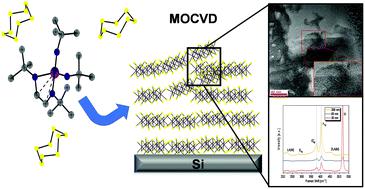当前位置:
X-MOL 学术
›
Dalton Trans.
›
论文详情
Our official English website, www.x-mol.net, welcomes your
feedback! (Note: you will need to create a separate account there.)
A new metalorganic chemical vapor deposition process for MoS2 with a 1,4-diazabutadienyl stabilized molybdenum precursor and elemental sulfur.
Dalton Transactions ( IF 3.5 ) Pub Date : 2020-08-28 , DOI: 10.1039/d0dt02471f Jan-Lucas Wree 1 , Engin Ciftyurek 2 , David Zanders 1 , Nils Boysen 1 , Aleksander Kostka 3 , Detlef Rogalla 4 , Maren Kasischke 5 , Andreas Ostendorf 5 , Klaus Schierbaum 2 , Anjana Devi 1
Dalton Transactions ( IF 3.5 ) Pub Date : 2020-08-28 , DOI: 10.1039/d0dt02471f Jan-Lucas Wree 1 , Engin Ciftyurek 2 , David Zanders 1 , Nils Boysen 1 , Aleksander Kostka 3 , Detlef Rogalla 4 , Maren Kasischke 5 , Andreas Ostendorf 5 , Klaus Schierbaum 2 , Anjana Devi 1
Affiliation

|
Molybdenum disulfide (MoS2) is known for its versatile properties and hence is promising for a wide range of applications. The fabrication of high quality MoS2 either as homogeneous films or as two-dimensional layers on large areas is thus the objective of intense research. Since industry requirements on MoS2 thin films can hardly be matched by established exfoliation fabrication methods, there is an enhanced need for developing new chemical vapor deposition (CVD) and atomic layer deposition (ALD) processes where a rational precursor selection is a crucial step. In this study, a new molybdenum precursor, namely 1,4-di-tert-butyl-1,4-diazabutadienyl-bis(tert-butylimido)molybdenum(VI) [Mo(NtBu)2(tBu2DAD)], is identified as a potential candidate. The combination of imido and chelating 1,4-diazadieneyl ligand moieties around the molybdenum metal center results in a monomeric compound possessing adequate thermal characteristics relevant for vapor phase deposition applications. Hexagonal MoS2 layers are fabricated in a metalorganic CVD (MOCVD) process with elemental sulfur as the co-reactant at temperatures between 600 °C and 800 °C. The structure and composition of the films are investigated by X-ray diffraction, high resolution transmission electron microscopy, synchrotron X-ray photoelectron spectroscopy and Raman spectroscopy revealing crystalline and stoichiometric MoS2 films. The new MOCVD process developed for MoS2 is highly promising due to its moderate process conditions, scalability and controlled targeted composition.
中文翻译:

一种用于 MoS2 的新金属有机化学气相沉积工艺,具有 1,4-二氮杂丁二烯基稳定的钼前体和元素硫。
二硫化钼 (MoS 2 ) 以其多功能特性而闻名,因此具有广泛的应用前景。因此,在大面积上制造高质量的 MoS 2作为均质薄膜或二维层是深入研究的目标。由于工业对 MoS 2薄膜的要求几乎无法通过已建立的剥离制造方法来满足,因此对开发新的化学气相沉积 (CVD) 和原子层沉积 (ALD) 工艺的需求增加,其中合理的前体选择是关键步骤。在这项研究中,一种新的钼前体,即 1,4-二叔丁基-1,4-二氮杂丁二烯基-双(叔丁基亚氨基)钼(VI) [Mo(N t Bu) 2 ( t Bu 2 DAD)],被确定为潜在的候选者。围绕钼金属中心的亚氨基和螯合 1,4-二氮杂二烯基配体部分的组合导致单体化合物具有与气相沉积应用相关的足够热特性。六边形MoS 2层是在金属有机CVD (MOCVD) 工艺中以元素硫作为共反应物在600 °C 至800 °C 之间的温度下制造的。通过 X 射线衍射、高分辨率透射电子显微镜、同步加速器 X 射线光电子能谱和拉曼光谱研究了薄膜的结构和组成,揭示了结晶和化学计量的 MoS 2电影。为 MoS 2开发的新 MOCVD 工艺因其温和的工艺条件、可扩展性和可控的目标成分而极具前景。
更新日期:2020-10-06
中文翻译:

一种用于 MoS2 的新金属有机化学气相沉积工艺,具有 1,4-二氮杂丁二烯基稳定的钼前体和元素硫。
二硫化钼 (MoS 2 ) 以其多功能特性而闻名,因此具有广泛的应用前景。因此,在大面积上制造高质量的 MoS 2作为均质薄膜或二维层是深入研究的目标。由于工业对 MoS 2薄膜的要求几乎无法通过已建立的剥离制造方法来满足,因此对开发新的化学气相沉积 (CVD) 和原子层沉积 (ALD) 工艺的需求增加,其中合理的前体选择是关键步骤。在这项研究中,一种新的钼前体,即 1,4-二叔丁基-1,4-二氮杂丁二烯基-双(叔丁基亚氨基)钼(VI) [Mo(N t Bu) 2 ( t Bu 2 DAD)],被确定为潜在的候选者。围绕钼金属中心的亚氨基和螯合 1,4-二氮杂二烯基配体部分的组合导致单体化合物具有与气相沉积应用相关的足够热特性。六边形MoS 2层是在金属有机CVD (MOCVD) 工艺中以元素硫作为共反应物在600 °C 至800 °C 之间的温度下制造的。通过 X 射线衍射、高分辨率透射电子显微镜、同步加速器 X 射线光电子能谱和拉曼光谱研究了薄膜的结构和组成,揭示了结晶和化学计量的 MoS 2电影。为 MoS 2开发的新 MOCVD 工艺因其温和的工艺条件、可扩展性和可控的目标成分而极具前景。











































 京公网安备 11010802027423号
京公网安备 11010802027423号